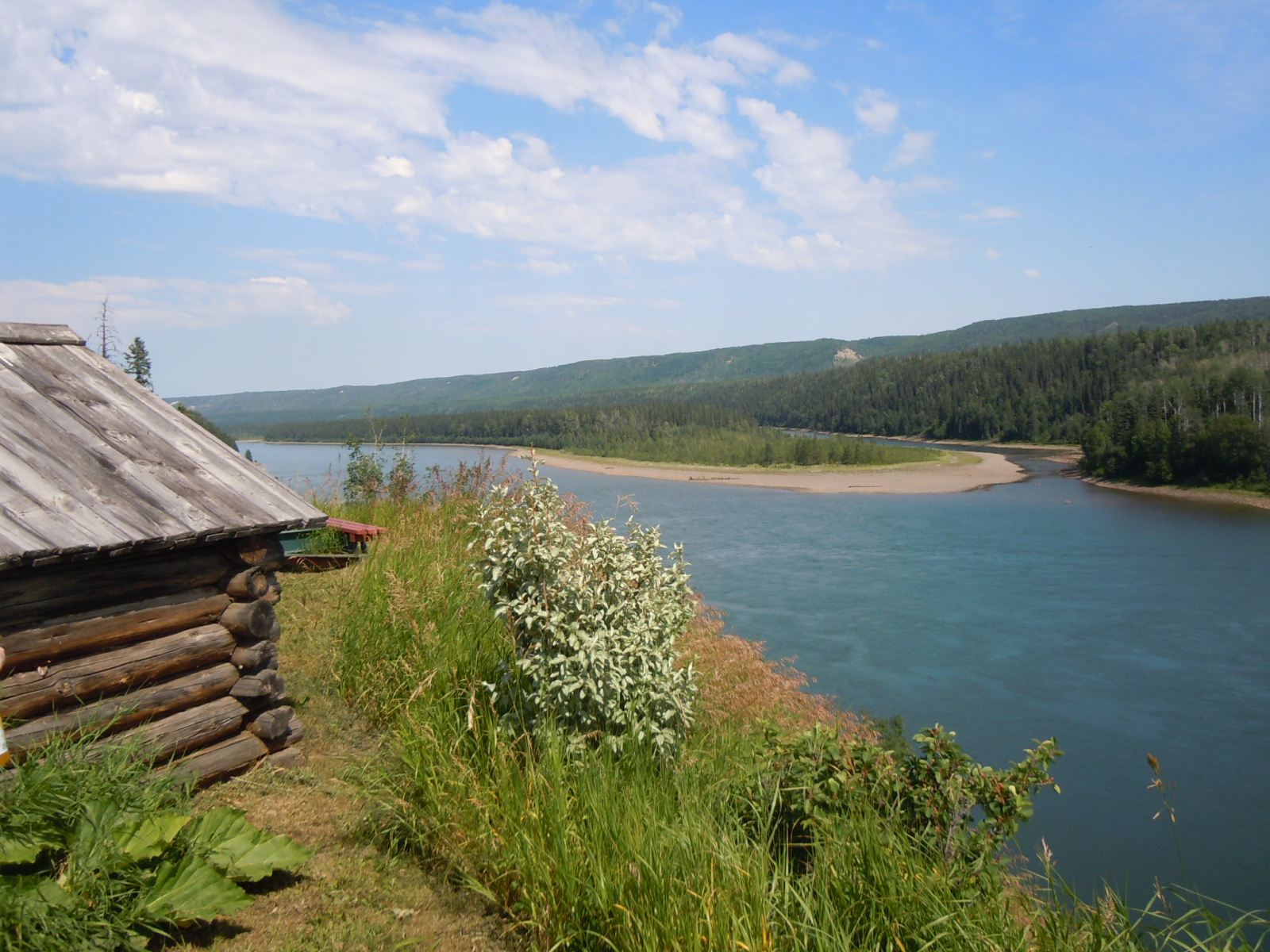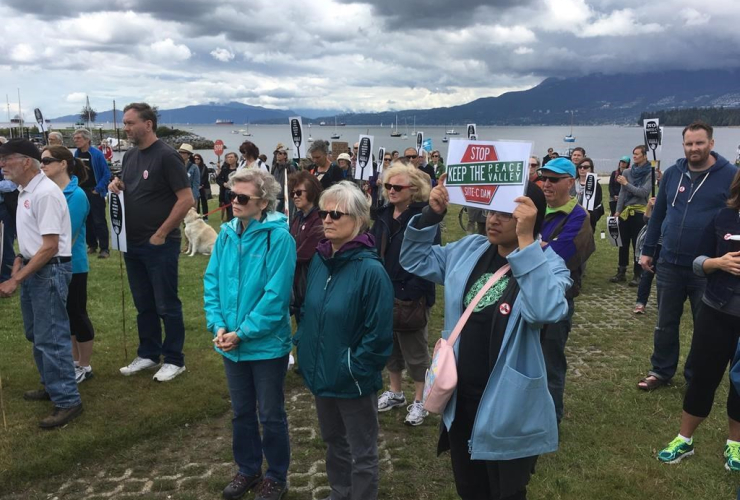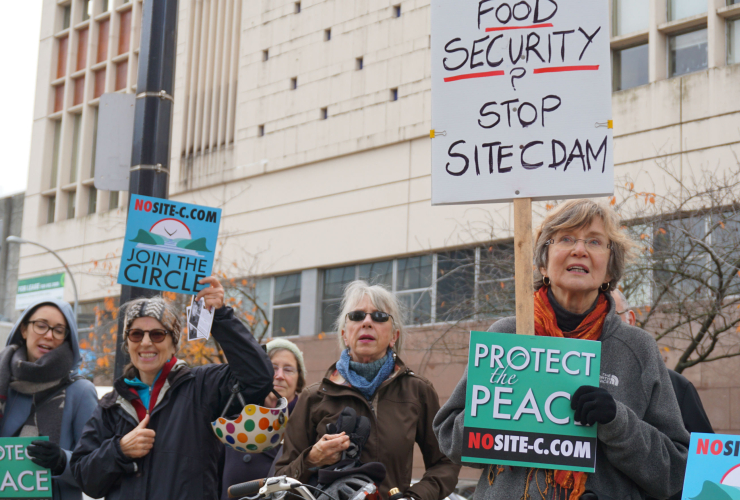When the Titanic, the iconic and storied ocean liner, was being built in company shipyards, its owners, White Star Line, claimed that “as far as it is possible to do, (the Titanic is) designed to be unsinkable.”
Even as the news was coming in that the Titanic was going down, the vice-president of White Star Line stated unequivocally to reporters: “We place absolute confidence in the Titanic. We believe that the boat is unsinkable.”
By all accounts, BC Hydro is behaving in the same feckless and irrational manner, as it continues to engage in shameless boosterism of the Site C dam on northeastern British Columbia's Peace River, aided by its unfailing allies, including liquefied natural gas industry partners (more on that later) and of course former B.C. Premier Christy Clark, who famously vowed to get the project “past the point of no return” before the recent provincial election—but failed to do so.
The recently fired head of BC Hydro, Jessica McDonald, typified the mindset of the now highly politicized Crown corporation and its close ties to BC Liberal ideology, when over two years ago she bluntly stated, in the face of widespread opposition and court challenges: “Our plan is to build Site C”.
There's no Plan B for Site C.
She and the former premier are like the owners of the Titanic, who adhered to their talking points even as the huge vessel was sinking, taking over 1,500 passengers and crew to the bottom of the Atlantic.
Flaws in the public relations fable
The big question is: why? What is motivating a publicly-owned Crown corporation to be so blindly committed to this massive and costly infrastructure project, despite wide-ranging, expert-driven and highly detailed pushback from scientists, local residents, First Nations, economists, social justice advocates and engineers around the world?
For years, BC Hydro and Clark have repeatedly directed attention to a carefully crafted narrative in which this industrial project—the largest in B.C.’s history—would supply “enough energy to power the equivalent of 450,000 homes per year in B.C.”
But cracks have appeared and slowly widened in this bounteous scenario, just like the unanticipated 400-metre long tension crack on the north bank of the Peace River that has already slowed preparation work at the dam site in the landslide-prone Peace River Valley.
Dangerous flaws have emerged in Hydro’s argumentation as important and cautionary as the massive sinkhole that appeared in 1996 in the giant WAC Bennett Dam, 119 km upstream from the Site C location—the sinkhole that cost BC Hydro $2 million a day in lost power production, terrified engineers, and threatened to destroy the entire downstream valley.
One giant crack in Hydro’s rampant enthusiasm for Site C—particularly in light of the BC Liberals' oft-repeated claim to be fiscally responsible—is the Oxford University study that appeared three years ago, which reviewed all major dam projects around the world built between 1934 and 2007, and showed that the overwhelming majority of large dams are simply not cost-effective.
Despite this and more contrary evidence, and like the builders of the Titanic, BC Hydro management has been soldiering on in their support for Site C, against common sense and a phalanx of direct challenges.
Resistance to Site C is everywhere
UBC’s Centre for Water Governance, chaired by Professor Karen Bakker, has published a lengthy report showing that far from being past the point of no return, Site C is economically so risky that the most fiscally responsible action would be to mothball the project and work on developing alternative energy sources such as solar, wind and geothermal.
Other deeply informed experts, like Harry Swain, former chair of the Joint Federal-Provincial Commission that examined the Site C proposal in 2014, and former BC Hydro Chair Marc Eliesen, have said the same thing.
Amnesty International has detailed how Site C, like similar large-scale infrastructure projects established in lightly populated areas, will devastate local social cohesion, and have a particularly harsh effect on Indigenous women.
Leading agrologists and biologists have pointed to the unique and irreplaceable agricultural and ecological potential of the 83 kilometres of the Peace River Valley that will be flooded if Site C goes ahead. They have pointed out that the valley’s Class 1 (highest quality) soils could grow food for up to a million people in food-insecure northeastern B.C., and calculated that the valley ecosystem contributes an astonishing $8.6 billion in ecological services.

The United Nations Educational, Scientific and Cultural Organization (UNESCO) has just issued a “highly critical” report expressing concern that changes in water flows caused by Site C will adversely affect downstream Wood Buffalo National Park. The park was declared a World Heritage Site by UNESCO in 1983.
First Nations communities up and down the Peace River Valley have been protesting against Site C for years, pointing out that it will destroy hunting grounds, sacred burial sites and end their 10,000-year-old way of life—a way of life guaranteed under Treaty 8.
It is not widely understood that a recent Supreme Court of Canada decision to not hear arguments from two First Nations against Site C, did not actually rule on the validity of Site C dam itself; Site C's validity has never been tested in court.
Given that critics of Site C are lined up locally, regionally and throughout Canada—and even around the world—what has given BC Hydro and the BC Liberal Party licence to ignore any and all detractors of the project?
I believe one need look no further than the oft-cited incestuous financial relationship between the oil and gas industry and the former BC Liberal government, and their penchant for acting as if global warming were an annoying fantasy that will go away if they act like it isn’t there.
The contamination of political gift-giving
Between 2008 and 2015 the fossil fuel sector—mostly large oil, gas and coal companies—has donated $5.2 million to political parties, the overwhelming majority of it to the BC Liberals. Some of these wealthy donors were offshore fossil fuel companies, or their representatives, with plans to build in B.C.; donations from such sources are considered illegal in most other jurisdictions.
The former Liberal government contended that such largesse did not influence its decision-making.
But consider this recent finding: paving companies that donated to the BC Liberals received almost twice as many contracts as companies that did not cross Liberal palms with silver.
Within my profession—medicine—there is abundant evidence, extending back over two decades, that conflicts of interest profoundly influence the outcome of “scientific” study in favour of the proponents’ self-interest.
BC Liberal public relations about the economy
During her two full terms as Premier of B.C., Christy Clark—no doubt inspired by her warm relationships with fossil fuel company executives—developed a core plan to build the province's economy around the liquefied natural gas industry (LNG) and its associated fracking.
Like the Duracell Bunny, Clark raced around the province for several years promoting LNG as B.C.’s prime moneymaker, always careful to use the word “clean” when describing this energy source. Not surprisingly, her conduct generated enthusiastic industry support for the Liberal Party. For example, Woodfibre LNG, an Indonesian-owned fossil fuel company with a questionable human rights record and a plan to build an LNG plant in Howe Sound, only a few kilometres from Vancouver, cheerfully footed the hefty bill for a party fundraiser at the tony Capilano Golf and Country Club in February, 2015.
A lobbyist for Fortis, the large natural gas company, was actually a member of the re-election team for the former provincial minister of the environment, Mary Polak.
In celebratory fashion, Christy Clark called the proposed—and since canceled—$36 billion Petronas LNG plant on Lelu Island off B.C.’s northern coast one of her biggest success stories. At the same press conference, she also mused that Site C was one of her most successful achievements. In her mind, all along, the two megaprojects were and are indissolubly linked.
As the years have rolled by, the promised jobs and economic prosperity distributed to British Columbians from the LNG industry failed to materialize. The Canadian Centre for Policy Alternatives pointed out in 2014 that the promise of 100,000 jobs and $1 trillion in economic opportunity was nothing more than political bafflegab.
LNG has tanked. Capped fracking wells dot the countryside in northeastern British Columbia, east of Fort St. John, where the province’s entire oil and gas industry is concentrated.
There’s just a touch of irony in the fact that the head office of the BC Oil and Gas Commission, located near the Fort St. John airport, is built to high energy efficiency standards, sharply reducing its fossil fuel requirements.

BC Oil and Gas Commission head office in Fort St. John is built to high energy efficiency standards, making for a touch of irony, says Warren Bell. Photo by Kane Consulting
Enter Site C
The favoured government fable, that Site C would be used to power 450,000 homes, has long ago fallen flat on its face. That’s because electricity requirements in B.C. have not increased for the last decade, and even declined slightly in the last year and a half.

The province actually has an electrical power surplus at present, fuelled in part by disastrous financial contracts with independent power producers. 
British Columbia currently enjoys a healthy surplus of available electrical energy. Graph courtesy of Eoin Finn/My Sea To Sky
As these facts have become more widely known, Christy Clark and her former officials have been forced to admit that Site C is not needed for domestic use within the province.
That has compelled a slowly expanding revelation of the real purpose of the elephantine Site C dam. Critics of the project often display an inflatable white elephant to symbolize the true nature of the Site C enterprise.
This is, unequivocally, to act as a life-support system for the greenhouse gas-producing, global warming-inducing, political-donation-dependent fossil fuel industry. In so doing, it’s as if Hydro’s senior management, like Donald Trump, believe global warming to be an irrelevant side-issue—or perhaps just a Chinese conspiracy.
The first reason for Site C playing this role is purely geographical. The proposed location of the dam is directly over the northern end of B.C.’s Montney Shale, the largest accessible methane gas deposit within B.C.’s borders.
The second reason was displayed when the Christy Clark government marched, either deliberately or accidentally, into a climate change dead end. After publicly declaring mandatory targets for reductions in the province’s climate-changing greenhouse gas production, it then served up, this past spring, a “Climate Leadership Plan” that egregiously failed to achieve those targets. Along the way it ignored just about every recommendation made by the very team of experts established to guide the plan’s creation.
Couple these two factors with a third—the precipitously declining cost and rapidly expanding deployment of renewable energy technologies such as solar photovoltaic panels, wind turbines and geothermal projects, as well as the overwhelming cost efficiency of reducing energy consumption—and it is quite clear that for the foreseeable future, B.C. families will not require more hydroelectricity for their own domestic uses.
They will, in fact, probably require less energy from Site C-style infrastructure. This is made especially obvious by the fact that during the last decade or so, the province’s population has increased by over half a million souls without increasing domestic energy requirements.
Perhaps that’s why Clark announced her abortive Climate Action Plan on a Friday afternoon, the day and time beloved of politicians anxious to slip through an announcement when it will garner the least public attention.
Undoubtedly anticipating broad-based condemnation of her party’s soon-to-be-released plan for climate change mitigation, which would not achieve GHG reduction goals, then-minister of environment Mary Polak finally revealed in May, 2017 that the government was going use electricity to power fracking.
On the one hand, the provincial Liberals would push forward and produce so-called “clean” energy from the Site C dam, hoping thereby to earn kudos from the environmental movement. On the other, they would take this energy and use it to power the gas industry and the plants that compress and liquefy fracked gas into LNG, thus reducing the fossil fuel industry’s carbon footprint and allowing the province to inch towards its stated greenhouse gas reduction targets.
“Clean” is not actually clean
Mothers generally teach their children that two wrongs do not make a right.
Using so-called “clean energy” to supply power to one of the “dirtiest” sources of energy may seem like a public relations coup, but in this case, it’s actually more like double trouble—the kind of tactic only a climate change-denying, fossil fuel industry-besotted government would resort to.
For starters, hydroelectric energy isn’t all that clean, because large amounts of methane gas are produced by decaying vegetation flooded upstream from dams.
For another, the reputation that natural gas itself has earned as a “clean” fossil fuel—to be used as a “bridge” fuel between coal and oil and renewable energy—has been robustly challenged. Some independent researchers have amassed strong evidence that fracking causes greater global warming effects than the fossil fuel usually condemned as the dirtiest of all: coal.
Reinforcing this evidence, a new study of methane leaks in BC from both active and capped wells shows that leakage rates are roughly two and a half times greater than has been previously claimed by both industry and government regulators.
So now it would appear that the former Liberal government and BC Hydro, recklessly indifferent to any climate change impact of their public policies, have plunged ahead with developing Site C, a hydroelectric megaproject that is going to contribute significantly to climate change, and will use the energy generated by that project to supply electricity to the LNG industry which will contribute even more significantly to climate change than previously estimated.
This flies in the face of a stern warning from Canada’s Environment Commissioner, Julie Gelfand, that all major infrastructure projects include a measurement of their climate impact.
And it ignores recent evidence, clearly outlined in a series of explicit graphs, and using the fossil fuel industry’s own data, showing that humankind is still producing more carbon dioxide and careering directly towards catastrophic elevation of global temperatures.
If this dam were to be built, it would also bring about massive “collateral damage.” It would destroy the way of life of Indigenous peoples in the region, uproot and disperse the Peace River farming community, cancel out ecological services that the Peace River Valley affords humanity for free, flood an expanse of the most productive soil in the province and make it inaccessible for food production, threaten the Wood Buffalo National Park, induce intense social stressors into Peace country communities, and deal British Columbians a powerful economic blow whose effects will last for decades.
And all this simply to gratify the failing fossil fuel industry by erecting an expensive structure that is a half-century out of date and set to augment decades-long financial burdens for coming generations in this province.
Frankly, if I were newly retired Christy Clark or part of the senior management of BC Hydro, I would be grateful to have been sidelined, because had they retained power and executed their irresponsible plans to build Site C, the echoes of their faulty rationale and foolhardy actions would have reverberated for decades down the road. They can now slip away and try to cover over Hydro’s disastrous financial status and the long-term burden it places on BC taxpayers.
Their anachronistic, ideologically-driven rhetoric may ensure a lucrative board position with one or more oil and gas companies down the road, whose ability to embrace the hard facts of the 21st century is also severely compromised.
Meanwhile, back in the real world, there is now an opportunity to terminate the economic, social and environmental disaster that is Site C.
And an opportunity for the rest of us to breathe a huge sigh of relief.






Comments